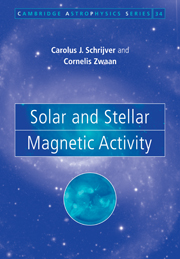Book contents
- Frontmatter
- Contents
- Preface
- 1 Introduction: solar features and terminology
- 2 Stellar structure
- 3 Solar differential rotation and meridional flow
- 4 Solar magnetic structure
- 5 Solar magnetic configurations
- 6 Global properties of the solar magnetic field
- 7 The solar dynamo
- 8 The solar outer atmosphere
- 9 Stellar outer atmospheres
- 10 Mechanisms of atmospheric heating
- 11 Activity and stellar properties
- 12 Stellar magnetic phenomena
- 13 Activity and rotation on evolutionary time scales
- 14 Activity in binary stars
- 15 Propositions on stellar dynamos
- Appendix I Unit conversions
- Bibliography
- Index
1 - Introduction: solar features and terminology
Published online by Cambridge University Press: 14 August 2009
- Frontmatter
- Contents
- Preface
- 1 Introduction: solar features and terminology
- 2 Stellar structure
- 3 Solar differential rotation and meridional flow
- 4 Solar magnetic structure
- 5 Solar magnetic configurations
- 6 Global properties of the solar magnetic field
- 7 The solar dynamo
- 8 The solar outer atmosphere
- 9 Stellar outer atmospheres
- 10 Mechanisms of atmospheric heating
- 11 Activity and stellar properties
- 12 Stellar magnetic phenomena
- 13 Activity and rotation on evolutionary time scales
- 14 Activity in binary stars
- 15 Propositions on stellar dynamos
- Appendix I Unit conversions
- Bibliography
- Index
Summary
The Sun serves as the source of inspiration and the touchstone in the study of stellar magnetic activity. The terminology developed in observational solar physics is also used in stellar studies of magnetic activity. Consequently, this first chapter provides a brief illustrated glossary of nonmagnetic and magnetic features, as they are visible on the Sun in various parts of the electromagnetic spectrum. For more illustrations and detailed descriptions, we refer to Bruzek and Durrant (1977), Foukal (1990), Golub and Pasachoff (1997), and Zirin (1988).
The photosphere is the deepest layer in the solar atmosphere that is visible in “white light” and in continuum windows in the visible spectrum. Conspicuous features of the photosphere are the limb darkening (Fig. 1.1a) and the granulation (Fig. 2.12), a time-dependent pattern of bright granules surrounded by darker intergranular lanes. These nonmagnetic phenomena are discussed in Sections 2.3.1 and 2.5.
The magnetic structure that stands out in the photosphere comprises dark sunspots and bright faculae (Figs. 1.1a and 1.2b). A large sunspot consists of a particularly dark umbra, which is (maybe only partly) surrounded by a less dark penumbra. Small sunspots without a penumbral structure are called pores. Photospheric faculae are visible in white light as brighter specks close to the limb.
The chromosphere is the intricately structured layer on top of the photosphere; it is transparent in the optical continuum spectrum, but it is optically thick in strong spectral lines.
- Type
- Chapter
- Information
- Solar and Stellar Magnetic Activity , pp. 1 - 9Publisher: Cambridge University PressPrint publication year: 2000



